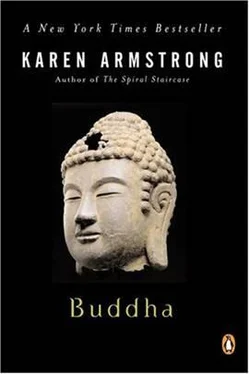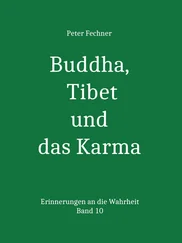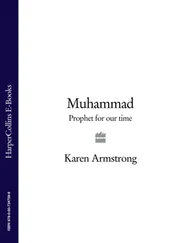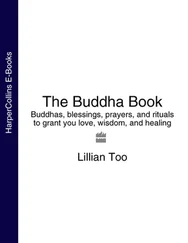But it must also be understood that the Four Noble Truths do not present a theory that can be judged by the rational intellect alone; they are not simply notional verities. The Buddha’s Dhamma was essentially a method, and it stands or falls not by its metaphysical acuity or its scientific accuracy, but by the extent to which it works. The truths claim to bring suffering to an end, not because people subscribe to a salvific creed and to certain beliefs, but because they adopt Gotama’s program or way of life. Over the centuries, men and women have indeed found that this regimen has brought them a measure of peace and insight. The Buddha’s claim, echoed by all the other great sages of the Axial Age, was that by reaching beyond themselves to a reality that transcends their rational understanding, men and women become fully human. The Buddha never claimed that his knowledge of the Four Noble Truths was unique, but that he was the first person, in this present era, to have “realized” them and made them a reality in his own life. He found that he had extinguished the craving, hatred and ignorance that hold humanity in thrall. He had attained Nibbana, and even though he was still subject to physical ailments and other vicissitudes, nothing could touch his inner peace or cause him serious mental pain. His method had worked. “The holy life has been lived out to its conclusion!” he cried out triumphantly at the end of that momentous night under the bodhi tree. “What had to be done has been accomplished; there is nothing else to do!”
Those of us who do not live according to the Buddhist program of morality and meditation have, therefore, no means of judging this claim. The Buddha was always quite clear that his Dhamma could not be understood by rational thinking alone. It only revealed its true significance when it was apprehended “directly,” according to yogic methods, and in the right ethical context. The Four Noble Truths do make logical sense, but they do not become compelling until an aspirant has learned to identify with them at a profound level and has integrated them with his own life. Then and only then will he experience the “exultation,” “joy” and “serenity” which, according to the Pali texts, come to us when we divest ourselves of egotism, liberate ourselves from the prison of self-centeredness, and see the Truths “as they really are.” Without the meditation and morality prescribed by the Buddha, the Truths remain as abstract as a musical score, which for most of us cannot reveal its true beauty on the page but needs to be orchestrated and interpreted by a skilled performer.
Even though the Truths make rational sense, the texts emphasize that they did not come to Gotama by means of discursive reasoning. As he sat meditating under the bodhi tree, they “rose up” in him, as from the depths of his being. He apprehended them within himself by the kind of “direct knowledge” acquired by a yogin who practices the disciplines of yoga with “diligence, ardor and self-control.” Gotama was so absorbed in these Truths, the object of his contemplation, that nothing interposed itself between them and his own mind and heart. He had become their human embodiment. When people observed the way he behaved and responded to events, they could see what the Dhamma was like; they could see Nibbana in human form. In order to share Gotama’s experience, we have to approach the Truths in a spirit of total self-abandonment. We have to be prepared to leave our old unregenerate selves behind. The compassionate morality and yoga devised by Gotama only brought liberation if the aspirant was ready to lay aside all egotism. It is significant that at the moment he achieved Nibbana under the bodhi tree, Gotama did not cry “I am liberated,” but “It is liberated!” He had transcended himself, achieved an exstasis, and discovered an enhanced “immeasurable” dimension of his humanity that he had not known before.
What did the new Buddha mean when he claimed to have reached Nibbana on that spring night? Had he himself, as the word implied, been “snuffed out,” extinguished like a candle flame? During his six-year quest, Gotama had not masochistically courted annihilation but had sought enlightenment. He had wanted to wake up to his full potential as a human person, not to be wiped out. Nibbana did not mean personal extinction: what had been snuffed out was not his personality but the fires of greed, hatred and delusion. As a result, he enjoyed a blessed “coolness” and peace. By tamping out the “unhelpful” states of mind, the Buddha had gained the peace which comes from selflessness; it is a condition that those of us who are still enmeshed in the cravings of egotism, which make us hostile toward others and distort our vision, cannot imagine. That is why the Buddha always refused, in the years following his enlightenment, to define or describe Nibbana: it would, he said, be “improper” to do so, because there are no words to describe such a state to an unenlightened person. The attainment of Nibbana did not mean that the Buddha would never experience any more suffering. He would grow old, get sick and die like everybody else and would experience pain while doing so. Nibbana does not give an awakened person trance-like immunity, but an inner haven which enables a man or woman to live with pain, to take possession of it, affirm it, and experience a profound peace of mind in the midst of suffering. Nibbana, therefore, is found within oneself, in the very heart of each person’s being. It is an entirely natural state; it is not bestowed by grace nor achieved for us by a supernatural savior; it can be reached by anybody who cultivates the path to enlightenment as assiduously as Gotama did. Nibbana is a still center; it gives meaning to life. People who lose touch with this quiet place and do not orient their lives toward it can fall apart. Artists, poets and musicians can only become fully creative if they work from this inner core of peace and integrity. Once a person has learned to access this nucleus of calm, he or she is no longer driven by conflicting fears and desires, and is able to face pain, sorrow and grief with equanimity. An enlightened or awakened human being has discovered a strength within that comes from being correctly centered, beyond the reach of selfishness.
Once he had found this inner realm of calm, which is Nibbana, Gotama had become a Buddha. He was convinced that, once egotism had been snuffed out, there would be no flames or fuel to spark a new existence, because the desire ( tanha ) which bound him to samsara had been finally quenched. When he died, he would attain his paranibbana, his final rest. Again, this did not mean total extinction, as Westerners sometimes assume. The paranibbana was a mode of existence that; we cannot conceive unless we have become enlightened ourselves. There are no words or concepts for it, because our language is derived from the sense data of our unhappy, mundane existence; we cannot really imagine a life in which there is no egotism of any kind. But that does not mean that such an existence is impossible; it became a Buddhist heresy to maintain that an enlightened person would cease to exist after death. In the same way, monotheists have insisted that there are no words that can adequately describe the reality they call “God.” “He who has gone to his final rest ( parinibbana ) cannot be defined by any measure,” the Buddha would tell his followers in later life. “There are no words capable of describing him. What thought might comprehend has been canceled out, and so has every mode of speech.” In purely mundane terms, Nibbana was “nothing,” not because it did not exist, but because it corresponded to no thing that we know. But those who had, by dint of the disciplines of yoga and compassionate morality, managed to access this still center within found that they enjoyed an immeasurably richer mode of being, because they had learned to live without the limitations of egotism.
Читать дальше












